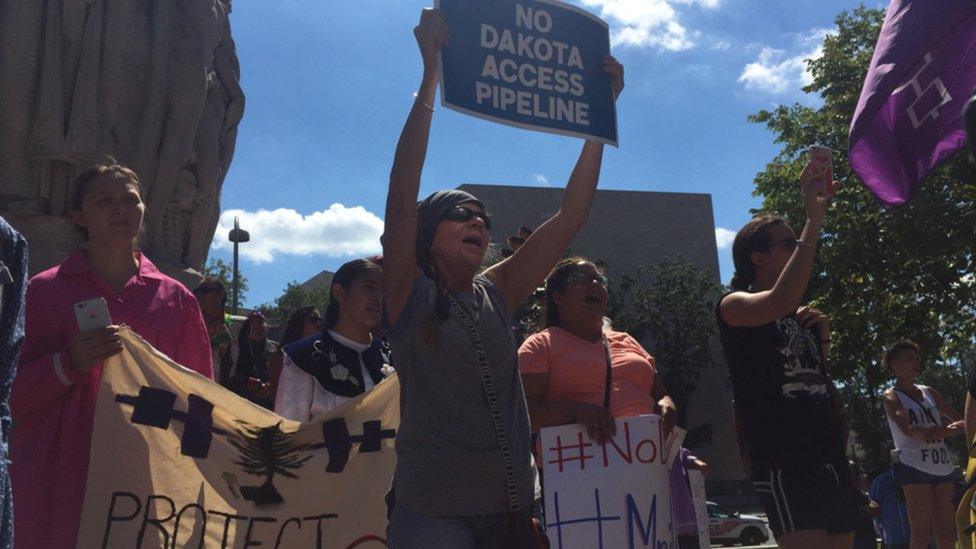Protests over huge N Dakota oil pipeline
- Published

More than 100 protesters have gathered in Washington DC to express their fears about a huge oil pipeline which will cross four states in the western US.
The $3.7bn (£2.8bn) Dakota Access pipeline has prompted huge protests, notably in North Dakota where Native Americans have halted its construction.
It will run 1,168 miles through Iowa, Illinois, and North and South Dakotas.
US District Judge James Boasberg said on Wednesday he will make a decision on the issue by 9 September.
Outside the court in the US capital, environmental activists made their feelings clear.
They believe the transporting of up to 570,000 barrels of crude oil a day will imperil local waterways.
The company behind the pipeline, Energy Transport Partners, has said the project will boost local economies and is much safer than transporting oil by rail or road. But protesters disagree.
Activists Desiree Fairooz and Lenny Bianchi were among the demonstrators outside the court, where a federal judge was set to consider the Standing Rock Sioux tribe's request for an injunction that would effectively block the pipeline's construction.
"We're concerned about the Native Americans and the threat to their water supply but we're also concerned about the fossil fuel issue," said Mr Bianchi, a Blue Mountain, Virginia native.
"We don't feel that we should be building pipelines, we feel that the money should instead be spent on alternative sources of energy."



At the scene - Courtney Subramanian, BBC News, Washington
Dozens of protesters convened outside the US District Court, with environmental activists and members of the Standing Rock Sioux tribe uniting behind one message - water is life.
The crowd was studded with signs bearing the words "native lives matter", "water is life" and "be on the right side of history, no DAPL [Dakota Access pipeline]."
Valentine Little Shield, a member of the Cheyenne River Sioux tribe in South Dakota, took a bus to Washington to show her support for the Standing Rock Nation Tribe.
Ms Little Shield describes the contested pipeline as personal. Her grandchildren use the waters where the pipeline poses a threat to swim, fish and bathe their horses.
"I'm here because of my grandkids and what they're going to go through," she said. "They can't drink the oil, they can't take a bath in the oil."

Generations of native Americans, both young and old, took turns sharing personal accounts of why halting the pipeline was important to them as crowd broke into battle cries and pounded tribal drums.
"We're not here to protest, we're here to protect," said Lance Frazier, a member of the Cheyenne River Sioux Tribe in Eagle Butte, South Dakota .
But for many, the pipeline symbolises a deeper issue among Native Americans.

Hundreds have joined the protests in North Dakota
Denise Desiderio, the policy director for the National Congress of American Indians, called the unilateral support of tribes across the country a "historic" moment.
"We need to make sure our tribal voice is heard and when we raise our voice, we need to make sure it transcends this issue," she said, noting the important symbolism of land to the Native American community.
"We have had enough lands taken away, we can't let what we have left be destroyed."
Hundreds of people have been occupying one of the construction sites in North Dakota, where tensions have been running high between demonstrators, police and builders.